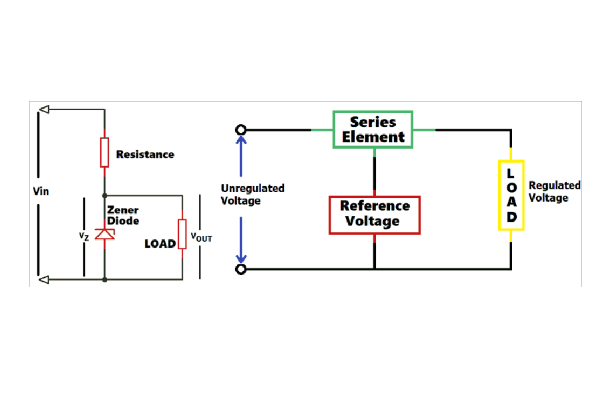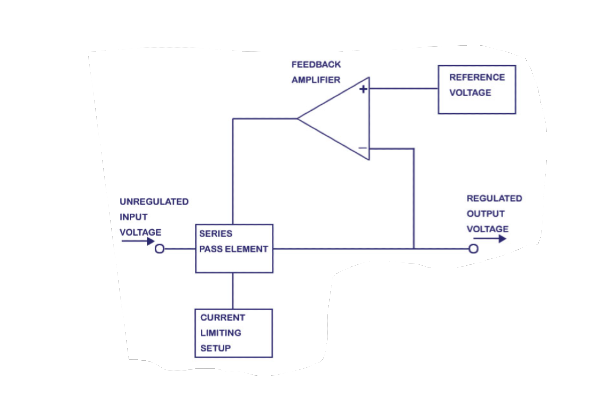- Home/
- GATE ELECTRONICS/
- GATE EC/
- Article
Voltage Regulator
By BYJU'S Exam Prep
Updated on: September 25th, 2023

Voltage Regulators play a vital role in the DC power supplies for converting the AC signal into a regulated DC signal. Based on the requirement, we will use the respective voltage regulator. We can convert the AC input into pulsating DC output using a rectifier. We will use the voltage regulator to get the regulated DC output voltage.
By using a DC supply, the ICs and most of the electronic devices can be operated. But we used to get the electrical signal to the houses in sinusoidal form (AC form). This article gives an overview of a voltage regulator along with its definition, circuit diagram, and classification.
Download Formulas for GATE Electronics & Communication Engineering – Control System
Table of content
What is Voltage Regulator?
The process of converting the sinusoidal (AC) signal into a pulsating DC signal is called Rectification. The electronic circuit, which performs the rectification, is known as Rectifier. We must convert this pulsating DC voltage into a regulated (constant) DC voltage.
Voltage Regulator Definition
The electronic circuit that operates on converting the DC voltage into a regulated (constant) DC voltage is known as a voltage regulator.
Download Formulas for GATE Electronics & Communication Engineering – Digital Circuits
Voltage Regulator Circuit Diagram
The circuit diagram of a voltage regulator is shown below:

We can classify voltage regulation into the following two types.
- Line Regulation: This parameter signifies maintaining the output voltage constant even if there is any variation in the input voltage. Line regulation is defined as the ratio of change in output voltage and change in input voltage & then multiply it by 100%.
Line Regulation= (∆Vout/∆Vin)×100%
- Load Regulation: This parameter signifies maintaining the output voltage constant even if there is any variation in the load current. Mathematically, load regulation is defined as
Load Regulation=[(VNL-VFL)/VFL]×100%
Download Formulas for GATE Electronics & Communication Engineering – Electronic Devices
Types of Voltage Regulators
As the name implies, a voltage regulator regulates the voltage at the output. There won’t be any ripples, or it will be as minimum as possible in the DC voltage output of this circuit. We can classify voltage regulators into two types. Now, let us discuss the following two types one by one.
- Linear Regulators: We can classify linear regulators into two types. Those are the series regulator and shunt regulator. We will connect the series regulator with the load, as the name implies. Similarly, we will connect the shunt regulator in shunt (parallel) with the load. The diagrams of these two linear regulators are shown below.
- Switching Regulators: As the name implies, the transistor will act as a switch in this regulator. At first, this regulator will pass the input voltage as pulses to the load. And then, to get smooth DC voltage, it will be filtered. Hence, this regulator is more efficient than linear regulators.
IC Voltage Regulator
If the voltage regulator is available in IC (Integrated Circuit) form, it is known as an IC voltage regulator. The output voltages of these regulators could be either positive or negative. These output voltages could be either fixed or adjustable.
IC Voltage Regulator Circuit Diagram

We can classify the IC voltage regulators into three types based on the nature of the output. Now, let us discuss the following three types one by one.
- Fixed Positive Voltage Regulator: As the name implies, this IC voltage regulator will produce the output voltage as positive and is of a fixed value. 78XX series IC voltage regulators will produce fixed positive voltages at the output. For example, the output voltage of 7805 IC is +5V.
- Fixed Negative Voltage Regulator: As the name implies, this IC voltage regulator will produce the output voltage as negative and is of a fixed value. 79XX series IC voltage regulators will produce fixed negative voltages at the output. For example, the output voltage of 7905 IC is -5V.
- Adjustable Voltage Regulator: Whenever we want to adjust the output voltage to the desired value regulated once, we can use this regulator. For example, by using LM317, we can adjust the output voltage to any value ranging from 1.2V to 37V.


